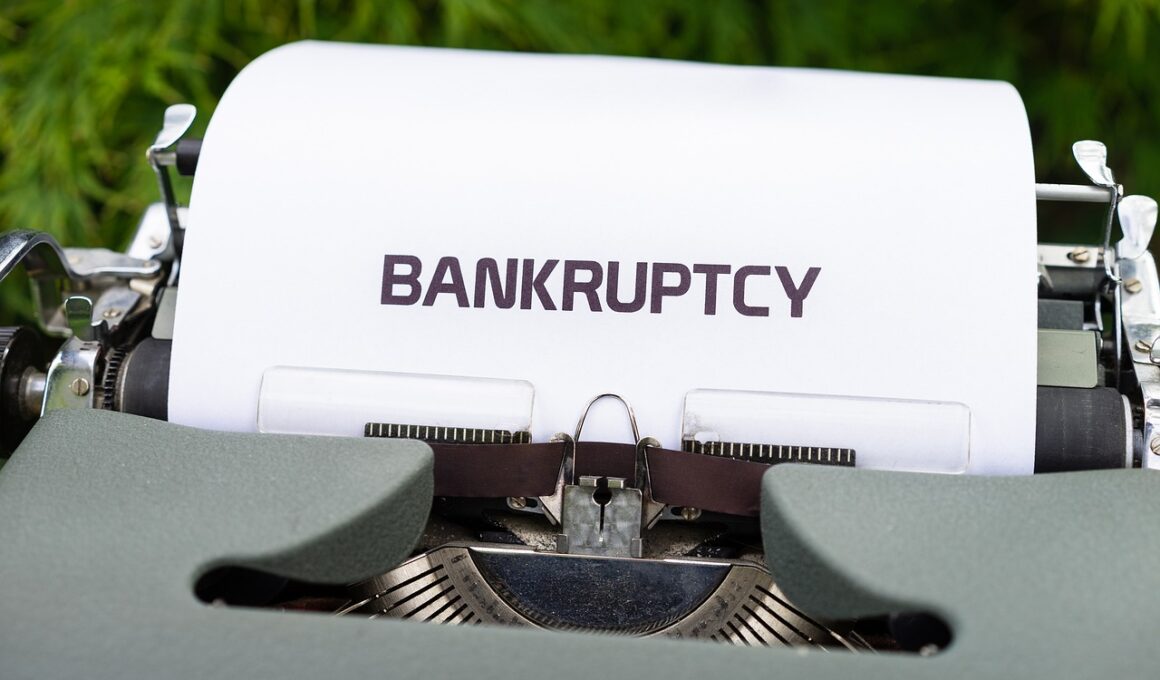The Truth Behind Bankruptcy and Credit Scores
Bankruptcy often carries a social stigma, leading many people to misunderstand its implications. Many believe that filing for bankruptcy is a permanent mark on a credit score; however, this isn’t entirely true. When individuals encounter severe financial distress, bankruptcy may be a reasonable option to regain control. It is important to understand how this legal process interacts with one’s credit score. Bankruptcy can significantly lower a score initially, but it isn’t the end of one’s credit journey. In fact, individuals may improve their scores by managing finances responsibly post-bankruptcy. It’s crucial to educate oneself about the different types of bankruptcy available, such as Chapter 7 and Chapter 13, as each varies in its impact on credit. Additionally, many creditors may continue to extend credit to individuals after bankruptcy, especially if they exhibit responsible credit behavior. Before considering bankruptcy, individuals should assess their financial situation and explore alternatives. Professional advice from a financial advisor or credit counselor can be beneficial. Knowledge is power when dealing with financial hardships, and dispelling myths surrounding bankruptcy can pave the way for recovery.
Another common misconception is that bankruptcy eliminates all debts. While some types of debts, like credit card loans, can be discharged, others, such as student loans or child support, typically remain. Individuals often enter bankruptcy believing that they will no longer owe anything to creditors, but learning the nuances of dischargeable versus non-dischargeable debts is crucial. Being informed about this aspect can help one make better decisions regarding debt management. Moreover, it’s essential to recognize that the specifics of each bankruptcy case may vary, leading to varying outcomes. Depending on individual circumstances, a person might still face some obligations even after filing. The perception that all debts are wiped clean can provide a false sense of hope and deter individuals from paying their creditor obligations that cannot be discharged in bankruptcy. Seeking clarity on what bankruptcy can and cannot do is vital for making informed choices. Consulting with legal professionals specializing in bankruptcy law could clarify many of these points. More importantly, maintaining open communication with creditors can often lead to manageable repayment plans, which could avoid the need for bankruptcy altogether.
Bankruptcy Impacts on Future Credit Opportunities
Many individuals fear that declaring bankruptcy will lock them out of future credit opportunities. The truth is that while bankruptcy can temporarily lower a credit score, it also provides opportunities for financial recovery. After bankruptcy, individuals can start building their credit again and even receive credit card offers targeted towards those with previous bankruptcies. Reestablishing credit is achievable by demonstrating responsible financial behavior, such as making timely payments and keeping low balances. Furthermore, as time progresses post-bankruptcy, the negative impact on one’s credit report diminishes. Most negative marks, including bankruptcy, fall off after seven to ten years depending on the type filed. Creditors will eventually look beyond past financial struggles if the individual shows consistency in repaying new debts. Organizations dedicated to helping individuals build their credit after bankruptcy can be incredibly beneficial. Education around budgeting and responsible spending plays a significant part in this journey. Financial literacy can empower individuals to understand credit scores better and align their future goals with sound money management practices. Therefore, embracing a proactive approach post-bankruptcy can enhance future financial opportunities significantly.
Another myth that needs addressing is that individuals who file for bankruptcy will never qualify for a mortgage. Surprisingly, many lenders specialize in working with those who have declared bankruptcy, looking beyond past credit troubles to evaluate current financial stability. More importantly, the Federal Housing Administration (FHA) allows individuals who have filed for bankruptcy to qualify for a mortgage as little as two years after discharge, provided they meet specific requirements. This timeline highlights how rehabilitation and growth can follow financial hardship, leading individuals toward homeownership. Beyond FHA programs, many lenders offer alternative loan options tailored for individuals with past bankruptcies. Staying informed about these programs can open up avenues for significant financial decisions. Restructuring one’s budget to accommodate future mortgage payments and demonstrating an improved financial profile can reflect positively to lenders. Ultimately, a proactive approach and understanding of the mortgage landscape can relieve the fears surrounding financial recovery. Therefore, equipping oneself with knowledge and resources better prepares individuals to reclaim their financial futures post-bankruptcy. Engaging with real estate professionals who are savvy about these matters can also help navigate potential challenges.
Understanding the Emotional Journey through Bankruptcy
The emotional aspect of facing bankruptcy cannot be underestimated. Individuals often experience feelings of shame, fear, and confusion, which can dramatically impact their mental health. It’s essential to recognize that these feelings are common and understandable when navigating such a challenging time. Speaking with family, friends, or professionals can help alleviate feelings of isolation. Additionally, support groups and online forums can provide a safe space for sharing experiences and gaining encouragement from those in similar situations. Understanding that one is not alone can serve as a powerful motivator for recovery; moreover, mental health professionals can provide therapeutic guidance on coping strategies. Delving into self-help resources, such as books and seminars on financial literacy, can foster personal growth, enabling stronger future financial habits. Embracing the journey can lead to newfound resilience and a stronger understanding of personal finances. The emotional hurdles associated with bankruptcy can transform individuals positively, converting difficult lessons into lifelong strategies for staying financially educated. Ultimately, recognizing these emotions as part of the recovery process promotes healing and empowers individuals to forge a new financial path.
Another critical area to examine is how bankruptcy affects credit inquiries and existing accounts. Many believe that a bankruptcy filing automatically closes all current accounts, leading to a major loss of credit. However, this is not always the case. Depending on the type of bankruptcy filed, some secured debt obligations may remain. Open accounts might still allow individuals to continue using them and build credit if managed prudently. Understanding the difference between secured and unsecured debts can greatly influence financial approaches. Secured debts, such as auto loans, are tied to physical assets, while unsecured debts include credit cards and personal loans. Efficient management concerning these distinctions can shed light on maintaining some credit accounts. Bringing awareness to these details allows individuals to navigate their credit processes more effectively. Persisting in responsible usage of remaining accounts can pave the way for restoring joy in financial life. Regular positive interactions with credit can foster community relationships that support credit rebuilding efforts. As always, knowledge is paramount; hence, enlightening oneself about the nuances of credit can elevate confidence and establish better financial management habits.
Conclusion: Embracing a Financially Healthier Future
In conclusion, navigating through bankruptcy is riddled with misconceptions that can distract from the goal of rehabilitation. Gaining clarity on credit scores, future lending opportunities, emotional elements, and maintaining accounts is vital for those in distress. The journey through bankruptcy can become a foundation for improved financial literacy and resilience. Being informed about the entire process encourages individuals to embrace their circumstances as an opportunity for growth rather than a permanent setback. As stigma dissipates through better understanding, individuals can focus on creating a brighter financial future. Seeking guidance from professionals who specialize in post-bankruptcy recovery can further enhance this journey. Additionally, engaging in continuous education about personal finance is crucial; every new lesson serves as an investment in future success. As individuals learn to harness their experiences, they can develop actionable strategies that foster healthy financial behavior moving forward. With perseverance and the right resources, reclaiming one’s financial story is entirely possible after bankruptcy. Embracing hope and recognizing progress is essential in achieving financial stability and reclaiming control over one’s financial destiny.


